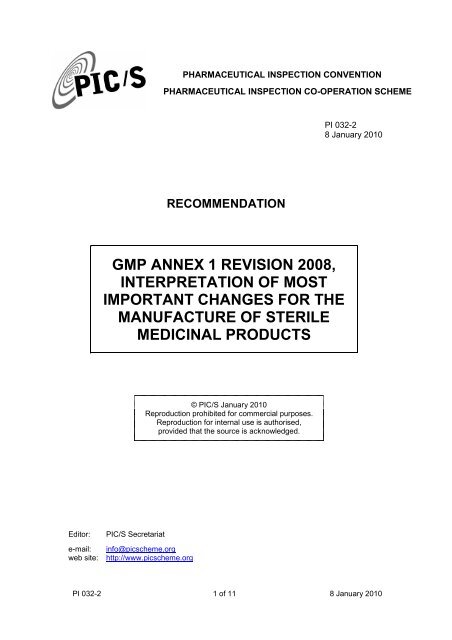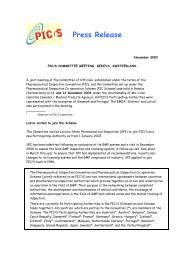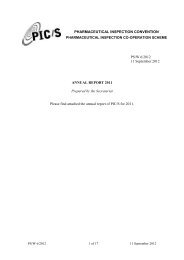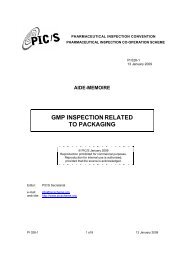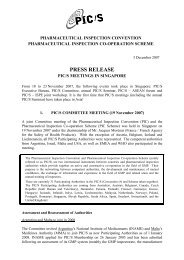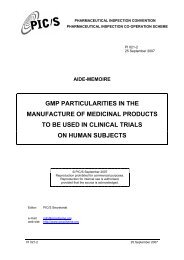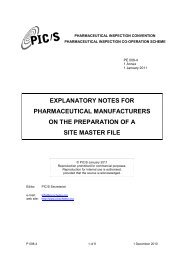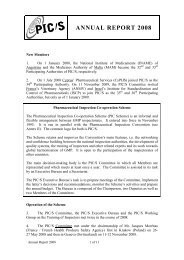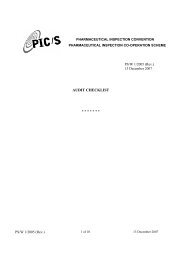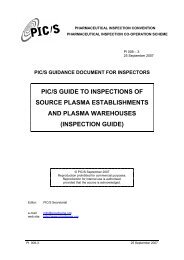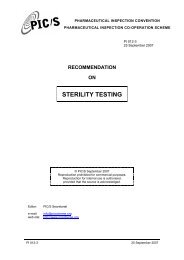gmp annex 1 revision 2008, interpretation of most important ... - PIC/S
gmp annex 1 revision 2008, interpretation of most important ... - PIC/S
gmp annex 1 revision 2008, interpretation of most important ... - PIC/S
Create successful ePaper yourself
Turn your PDF publications into a flip-book with our unique Google optimized e-Paper software.
PHARMACEUTICAL INSPECTION CONVENTIONPHARMACEUTICAL INSPECTION CO-OPERATION SCHEMEPI 032-28 January 2010RECOMMENDATIONGMP ANNEX 1 REVISION <strong>2008</strong>,INTERPRETATION OF MOSTIMPORTANT CHANGES FOR THEMANUFACTURE OF STERILEMEDICINAL PRODUCTS© <strong>PIC</strong>/S January 2010Reproduction prohibited for commercial purposes.Reproduction for internal use is authorised,provided that the source is acknowledged.Editor:<strong>PIC</strong>/S Secretariate-mail: info@picscheme.orgweb site: http://www.picscheme.orgPI 032-2 1 <strong>of</strong> 11 8 January 2010
Index0. Document history............................................................................................... 21. Purpose and scope............................................................................................ 22. Basics................................................................................................................ 32.1 Legal requirements (binding) ............................................................................. 32.2 Regulatory guidance (to be justified if not applied)............................................. 32.3 Relevant international norms (to be justified if not applied) ................................ 33. Definitions and abbreviations ............................................................................. 34. New texts and their <strong>interpretation</strong>....................................................................... 44.1 Clean room / clean air device classification........................................................ 44.2 Clean room / clean air device monitoring ........................................................... 54.3 Microbiological monitoring.................................................................................. 74.4 Media simulations .............................................................................................. 74.5 Pre-sterilisation bioburden monitoring................................................................ 74.6 Provisions for environmental conditions for the handling <strong>of</strong> aseptically filledvials after leaving the aseptic processing area up until final sealing................... 85. Revision history ............................................................................................... 110. Document historyThe present technical <strong>interpretation</strong> <strong>of</strong> Annex 1 to the <strong>PIC</strong>/S GMP Guide (PE 009) onthe manufacture <strong>of</strong> sterile medicinal products (hereinafter referred to as GMPAnnex 1) was initially drafted by Switzerland / Swissmedic and then commented by<strong>PIC</strong>/S Participating Authorities. It was agreed that the technical <strong>interpretation</strong> <strong>of</strong>GMP Annex 1 should be the same between the EU and <strong>PIC</strong>/S 1 .Adoption by Committee <strong>of</strong> PI 032-1 3 November 2009Entry into force <strong>of</strong> PI 032-1 1 December 2009Entry into force <strong>of</strong> PI 032-2 1 January 20101. Purpose and scopeIn order to assure a harmonised conduct <strong>of</strong> inspections, with respect to the <strong>2008</strong><strong>revision</strong> <strong>of</strong> GMP Annex 1 2 , this document summarises the <strong>interpretation</strong>s which aninspector <strong>of</strong> the competent regulatory authority should adopt when performing aninspection <strong>of</strong> a manufacturer <strong>of</strong> sterile medicinal products.This document reflects the <strong>most</strong> <strong>important</strong> changes and also addresses the feedbackfrom industry concerning the GMP Annex 1 Revision. It is not meant to address allchanges within the Revision.1 Annex 1 <strong>of</strong> the <strong>PIC</strong>/S GMP Guide is identical to Annex 1 <strong>of</strong> the EU GMP Guide (EudralexVolume 4 GMP). Both Guides are equivalent in terms <strong>of</strong> GMP requirements.2 The <strong>revision</strong> <strong>of</strong> Annex 1 to <strong>PIC</strong>/S GMP Guide was adopted on 12 November <strong>2008</strong> by the<strong>PIC</strong>/S Committee and entered into force on 1 March 2009.PI 032-2 2 <strong>of</strong> 11 8 January 2010
2. Basics2.1 Legal requirements (binding)• Refer to national legislation 32.2 Regulatory guidance (to be justified if not applied)• For EEA countries: Eudralex Volume 4 GMP, GMP Annex 1, <strong>revision</strong> <strong>of</strong>November 25th, <strong>2008</strong>• For non-EEA countries: <strong>PIC</strong>/S GMP Guide (PE 009), Annex 1 or equivalent2.3 Relevant international norms (to be justified if not applied)• EN ISO 14644-1• EN ISO 14644-2• EN ISO 14644-3• EN ISO 14644-4• EN ISO 14644-5• EN ISO 14644-6The relevant international norms used in the context <strong>of</strong> this paper were applicable atthe time this document was drafted. Future <strong>revision</strong>s <strong>of</strong> these norms do notautomatically apply to this document.The GMP Annex 1 Revision came into effect on March 1 st , 2009; the provisions forcrimp capping for all vials will come into effect in March 1 st , 2010. However,especially for new installations with respect to crimp capping, conformance with therevised GMP Annex 1 is to be encouraged already today.3. Definitions and abbreviationsRoom ClassificationRABSRoom classification is part <strong>of</strong> the initial qualification <strong>of</strong> a facilityand is also normally performed during routine re-qualification.Both, classification activities and the final / to be achievedclassification status for clean rooms / clean air devices aremeant. This Annex directly links to clean room / clean airdevice classification according to ISO 14644. For qualificationand validation and re-qualification see also <strong>PIC</strong>/S GMP GuideAnnex 15.Restricted Access Barrier Systems3 E.g. for Switzerland: Federal Law on Medicinal Products and Medical Devices (Law onTherapeutic Products - LTP), SR 812.21 and Ordinance on Establishment Licenses (ELO),SR 812.212.1.PI 032-2 3 <strong>of</strong> 11 8 January 2010
4. New texts and their <strong>interpretation</strong>4.1 Clean room / clean air device classificationGeneral <strong>interpretation</strong>: The GMP Annex 1 Revision distinguishes very clearlybetween clean room / clean air device classification which is described in sections 4to 7, and clean room monitoring, which is described in sections 8 to 20.Section 3 defines at rest and in operation states, which is not new. However, itshould be noted that the company needs SOPs to define at rest and in operationstates, which might be specifically required per production room. These SOPs shouldinclude a definition <strong>of</strong> equipment to be installed and running, number <strong>of</strong> operators tobe present.In general, clean room / clean air device classification is required to be performedaccording to EN ISO 14644-1 with the applicable limits for particle counts defined inthe table in section 4 <strong>of</strong> GMP Annex 1. Probe-locations should be chosen in order todemonstrate the homogeneity across the room. A classification report should beprepared according to section 4.4 <strong>of</strong> ISO 14644-1 and section B.1.4 <strong>of</strong> ISO 14644-3.Monitoring, on the other hand, does not need to be performed according to EN ISO14644-1. It can be performed for a reduced number <strong>of</strong> sampling points and samplingvolumes. A formal risk analysis study based on experiments and analysis <strong>of</strong> themonitoring data (over at least 6 month operation) should provide a basis for thedetermination <strong>of</strong> frequencies and limits. Frequencies and limits should be processbasedand the results <strong>of</strong> the initial qualification and on going monitoring should betaken into account when setting operational alert and action limits. These limits andsample locations should be periodically reviewed for on-going validity <strong>of</strong> the risksinitially considered.Those frequencies and limits should be process-based and the results <strong>of</strong> thequalification should be taken into account.Section 4:New text: Clean rooms and clean air devices should be classified in accordance withEN ISO 14644-1. Classification should be clearly differentiated from operationalprocess environmental monitoring.Interpretation: Classification <strong>of</strong> clean rooms / clean air devices should be doneaccording to provisions in EN ISO 14644-1. Compared with the prior version, thevalues for maximum permitted particles have been changed in this section.Especially the values for the maximum permitted number <strong>of</strong> 5 µm particles / m 3 forgrade A have been changed from 1 to 20. For grade A, the corresponding ISO classis 4.8, based on the 5 µm counts.For grade D, no in operation limits are defined; the company should establish inoperation limits based on a risk analysis and on historical data where applicable.Section 5:New text: For classification purposes EN/ISO 14644-1 methodology defines both theminimum number <strong>of</strong> sampling locations and the sample size.PI 032-2 4 <strong>of</strong> 11 8 January 2010
Interpretation: Minimum amount <strong>of</strong> sampling points and sampling volume and also<strong>interpretation</strong> <strong>of</strong> the results are defined in EN ISO 14644-1 (confidence interval). Seealso provisions for outliers in appendix B 6.2 <strong>of</strong> EN ISO 14644-1.ISO 14644-1 Annex f has an informative section on the use <strong>of</strong> sequential samplingtechniques for non-viable particle monitoring. This technique may be useful inreducing the time needed for sampling very large clean-room areas, at rest. Thismethod would not be considered suitable for “in operation” classification.The application <strong>of</strong> this method may be acceptable but it is unlikely to be the preferredmethod since <strong>most</strong> pharmaceutical facilities do not normally have the very largeclean rooms <strong>of</strong> the type discussed in Annex f and therefore it is unlikely thatsignificant time would be saved.Section 6:New text: Portable particle counters with a short length <strong>of</strong> sample tubing should beused for classification purposes because <strong>of</strong> the relatively higher rate <strong>of</strong> precipitation<strong>of</strong> particles ≥ 5 µm in remote sampling systems with long lengths <strong>of</strong> tubing.Interpretation: This section implies that old central particle counters with long tubelengths will no longer be acceptable for clean room classification, as they absorb toomany particles (especially 5 µm particles). Therefore, modern portable particlecounters with short tubes or (even preferable when possible) those without tubesshould be used for classification purposes. The certificate <strong>of</strong> calibration <strong>of</strong> the particlecounter should mention the tube length and nature <strong>of</strong> material (inox or polymer).When calibration <strong>of</strong> the particle counter is performed outside by an externallaboratory, the particle counting system should be qualified on site with acomparative measurement with an isokinetic probe. For impact on monitoring, seealso section 11.Section 7:New text: EN ISO 14644-2 provides information on testing to demonstrate continuedcompliance with the assigned cleanliness classifications.Interpretation: This provision concerns clean room re-qualification. The company maychoose to perform re-qualification <strong>of</strong> clean rooms according to provisions in EN ISO14644-2 (including the proposed frequencies). For re-qualification <strong>of</strong> grade A areas, itis generally expected to carry out the following activities also performed during initialclassification: air velocity, filter integrity, differential pressure every 6 months. Otherexamples for frequencies: grade B: every 6 months at rest, once a year in operation;other grades: once a year, with maximum delay defined. If the company takesanother approach, this should be justified, e.g. based on monitoring data.4.2 Clean room / clean air device monitoringSection 8:New text: Clean rooms and clean air devices should be routinely monitored inoperation and the monitoring locations based on a formal risk analysis study and theresults obtained during the classification <strong>of</strong> rooms and/or clean air devices.PI 032-2 5 <strong>of</strong> 11 8 January 2010
Interpretation: Frequency, location and number <strong>of</strong> monitoring locations should bebased on a formal risk assessment and not on ISO 14644-1. Data obtained duringclassification and previous monitoring data should be considered. Critical locationsshould be covered.Section 9:New text: For grade A zones, particle monitoring should be undertaken for the fullduration <strong>of</strong> critical processing, including equipment assembly, except where justifiedby contaminants in the process that would damage the particle counter or present ahazard, e.g. live organisms and radiological hazards. The grade A zone should bemonitored at such a frequency and with suitable sample size that all interventions,transient events and any system deterioration would be captured and alarmstriggered if alert limits are exceeded.Interpretation: In critical areas with exposed product continuous monitoring, coveringthe duration <strong>of</strong> the operations is expected. Continuous means that the system mustbe able to pick up any potentially occurring event <strong>of</strong> an unusual number <strong>of</strong> particles,including an event that occurs for a short time only. Manifold systems might not besuitable for Grade A Zone monitoring due to a lack in responsiveness. It is <strong>important</strong>that monitoring in grade A comprises equipment assembly, because there is a highimpact <strong>of</strong> the human operator. An SOP should be present defining alert levels andpre-defined corrective measures in cases <strong>of</strong> alerts and interventions.Section 10:New text: It is recommended that a similar system be used for Grade B zonesalthough the sample frequency may be decreased. The Grade B zone should bemonitored at such a frequency and with suitable sample size that changes in levels <strong>of</strong>contamination and any system deterioration would be captured and alarms triggeredif alert limits are exceeded.Interpretation: Continuous monitoring (see definition under <strong>interpretation</strong> to section 9)is expected while not fully integral containers are handled in the B zone, e.g. partiallystoppered vials within a laminar air flow mobile unit prior to lyophilisation. Manifoldsystems might not be suitable for Grade B Zone monitoring due to a lack inresponsiveness.Section 11:New text: Airborne particle monitoring systems may consist <strong>of</strong> independent particlecounters; a network <strong>of</strong> sequentially accessed sampling points connected by manifoldto a single particle counter; or a combination <strong>of</strong> the two. The system selected mustbe appropriate for the particle size considered. Where remote sampling systems areused, the length <strong>of</strong> tubing and radii <strong>of</strong> any bends in the tubing must be considered inthe context <strong>of</strong> particle losses in the tubing.Interpretation: This section addresses concerns especially for the sedimentation <strong>of</strong>5 µm particles in remote systems (as a rough example, s-shaped bent tubing <strong>of</strong> 1.5m length can already absorb about 30% <strong>of</strong> the 5 µm particles.). The company mustqualify their particle sampler and sampling system for both particle sizes, 0.5 µm and5 µm.PI 032-2 6 <strong>of</strong> 11 8 January 2010
Section 12:New text: It is not necessary for the sample volume to be the same as that used forformal classification.Interpretation: The <strong>important</strong> point for sampling during monitoring is to be able tosample quickly (especially in critical areas), to be able to link a particle excursion toan actual event and to be able to generate an alarm so that operators areimmediately aware <strong>of</strong> the alarm situation. Thus sampling <strong>of</strong> 1 m 3 (which <strong>of</strong>ten takes30 minutes) could be inadequate during monitoring <strong>of</strong> an A zone during operation.Section 15:New text: The monitoring <strong>of</strong> Grade C and D areas in operation should be performedin accordance with the principles <strong>of</strong> quality risk management. The requirements andalert/action limits will depend on the nature <strong>of</strong> the operations carried out, but therecommended “clean up period” should be attained.Interpretation: The number <strong>of</strong> sampling points and the sampling frequency are to bedetermined by at least a risk assessment, including risk identification, risk analysisand risk evaluation (see also GMP Annex 20). There is no need for a continuousmonitoring. However, the frequency should be higher than that <strong>of</strong> Re-Qualification <strong>of</strong>these areas.4.3 Microbiological monitoringThere are no changes to the provisions for microbiological monitoring (sections 18and 19).However, it is <strong>important</strong> to note that for critical sampling locations in grade A areaswhere aseptic operations are performed, every found microorganism should result ina thorough investigation, the microorganism has to be identified and impact on batchrelease should be considered. An additional comment should be made on the limitsfor settle plates. These limits are interpreted as limit per settle plate. Also, the samelimits apply when sampling time is less than 4 hours, e.g. for operations being shorterthan 4 hours.All methods indicated for a specific grade in the table <strong>of</strong> section 19 should be usedfor monitoring the area <strong>of</strong> that specific grade. If one <strong>of</strong> the methods is not used, thisshould be justified.4.4 Media simulationsThe provisions for media simulations (sections 66-71) are now fully harmonized withFDA aseptic guide. This should not give rise to problems. Section 7 includes a needfor media fills to be done under worst-case conditions.4.5 Bioburden monitoringSection 80:New text: The bioburden should be monitored before sterilisation. There should beworking limits on contamination immediately before sterilisation, which are related tothe efficiency <strong>of</strong> the method to be used. Bioburden assay should be performed onPI 032-2 7 <strong>of</strong> 11 8 January 2010
each batch for both aseptically filled product and terminally sterilised products.Where overkill sterilisation parameters are set for terminally sterilised products,bioburden might be monitored only at suitable scheduled intervals. For parametricrelease systems, bioburden assays should be performed on each batch andconsidered as an in-process test. Where appropriate the level <strong>of</strong> Endotoxins shouldbe monitored. All solutions, in particular large volume infusion fluids, should bepassed through a micro-organism-retaining filter, if possible sited immediately beforefilling.Interpretation:General: The contribution to bioburden <strong>of</strong> the various raw materials and packagingmaterials together with the manufacturing processes prior to the sterilisation stepshould be understood and controlled. A monitoring and control strategy includingperiodic monitoring and trending <strong>of</strong> bioburden prior to any bioburden reduction stepshould be established and justified on the basis <strong>of</strong> process risks. Volumes sampledshould be justified and take account <strong>of</strong> the expected level <strong>of</strong> contaminationThe bioburden should at least be determined for the product prior to the finalsterilization step. Acceptance criteria for bioburden must be based on the sterilisingstep, a sterility assurance level <strong>of</strong> 10 -6 must be met. The results <strong>of</strong> the bioburdenassays must be present before release (unless an overkill cycle is used for terminalsterilisation). This favours the use <strong>of</strong> rapid micro-methods.A risk assessment should be performed in order to determine the need for endotoxinstudies. When needed, endotoxins should be determined also for the units <strong>of</strong> productthat were filled the last.Terminal sterilisation: For terminal sterilisation the F 0 value has to be taken intoaccount. The sampling should be performed on filled containers prior to sterilisation.For overkill sterilisation processes for terminally sterilized products, the companymust justify the intervals chosen for bioburden testing.Aseptic operations: For sterile filtration, filter efficacy studies must be taken intoaccount when determining the acceptance criteria for the bioburden prior to filtration.This means that if two subsequent filtration steps are used, product has to besampled prior to the last filtration step, if technically possible, e.g. first filtration intobulk tank, second filtration immediately prior to filling. However, if a system <strong>of</strong> tw<strong>of</strong>ilters with redundancy is used (the second filter is used for security, if one fails therequired SAL is still achieved), sampling should be performed upstream <strong>of</strong> thesefilters in order not to compromise the filtration step. The company has to justify itsapproach if sampling is done before the first filtration step.4.6 Provisions for environmental conditions for the handling <strong>of</strong> asepticallyfilled vials after leaving the aseptic processing area up until final sealingGeneral <strong>interpretation</strong>: these provisions are valid not only for freeze-dried vials but forall aseptically filled vials. If crimp-capping is done as a “clean process” (see section120) these provisions define requirements for the environment for vials from themoment they leave the aseptic processing area until the crimp cap has been crimpedinto place on the stoppered vial. Grade A air supply is required for conveyor tunnelsconnecting the aseptic processing area with the crimp capping machine for liquidproducts and powder, and the transport <strong>of</strong> freeze-dried vials from the freeze dryer tothe crimp capping machine and the crimp capping machine itself.PI 032-2 8 <strong>of</strong> 11 8 January 2010
Grade D classification is considered to be the minimal requirement for the clean roomin which the crimp-capping machine is located. The company has to justify theirapproach for choosing the appropriate room class.It is <strong>important</strong> to note that in order to avoid contamination <strong>of</strong> the product at this stage,not only one but several factors are <strong>important</strong> such as the design <strong>of</strong> the vial stoppercombination, a thoroughly validated detection systems <strong>of</strong> misplaced or missingstoppers, restricted access <strong>of</strong> operators, good training <strong>of</strong> operators, thoroughprocedures for manual interventions and follow-up actions and adequateenvironmental conditions.Section 116:New text: Partially stoppered freeze drying vials should be maintained under grade Aconditions at all times until the stopper is fully inserted.Interpretation: There should be no problem with this point, which is basicallyequivalent with the provisions in section 12 <strong>of</strong> the prior version <strong>of</strong> the Annex.Section 118:New text: The container closure system for aseptically filled vials is not fully integraluntil the aluminium cap has been crimped into place on the stoppered vial.Interpretation: This is to be used as a definition. It does not mean that the product isconsidered open prior to crimp capping and therefore it is not a requirement foraseptic conditions up to crimp capping. However, for more detail on specificrequirements see section 120.Section 120:New text: Vial capping can be undertaken as an aseptic process using sterilized capsor as a clean process outside the aseptic core. Where this latter approach isadopted, vials should be protected by grade A conditions up to the point <strong>of</strong> leavingthe aseptic processing area, and thereafter stoppered vials should be protected witha grade A air supply until the cap has been crimped.Interpretation: For lyophilized products: product transfer from filling machine to freezedryer should be done under grade A conditions (e.g. laminar air flow mobile unit) withgrade B surroundings. Transfer to the crimp-capping machine should be done undergrade A air supply. For liquid products and powders: transfer from the asepticprocessing area to the crimp capping machine should be done under grade A airsupply. For all products: Crimp capping should be done under grade A air supply.Sterilization <strong>of</strong> crimp caps is only mandatory, when crimp capping is performed in theaseptic core.The new <strong>revision</strong> <strong>of</strong> Annex 1 mentions a new term, Grade A air supply, but nodefinition <strong>of</strong> this new term is given in the revised Annex. Inspectors and Industrytherefore need an <strong>interpretation</strong> <strong>of</strong> this term, especially as a provision <strong>of</strong> a grade A airsupply is one <strong>of</strong> the <strong>most</strong> significant changes in Annex 1.The term grade A air supply is specifically used to describe a supply <strong>of</strong> air which isHEPA filtered, and at the point <strong>of</strong> supply meets when tested, the non-viableparticulate requirements <strong>of</strong> a grade A area, as defined in paragraph 4 <strong>of</strong> the revisedAnnex 1. It is <strong>important</strong> to differentiate between the terms grade A air supply andPI 032-2 9 <strong>of</strong> 11 8 January 2010
grade A area. A grade A air supply should be qualified and monitored as follows:Qualification requirements:• Qualification is done only under at rest conditions: For the crimp-cappingmachine the at-rest state is achieved when the air supply is switched on, thecrimp-capping machine is operating (feeding <strong>of</strong> vials and crimp caps is notconsidered necessary) and there is no interference by operators. For theconveyor tunnel for liquid products the at-rest state is achieved when the airsupply is switched on, the conveyor belt is switched on and there is nointerference by operators.• Non-viable particles should be measured and are expected to meet grade Arequirements. The probe should be located at the point <strong>of</strong> supply <strong>of</strong> the filteredair.• Smoke studies should be performed. Whilst unidirectional air flow is notrequired, efficient protection <strong>of</strong> the vials should be demonstrated and theabsence <strong>of</strong> air entrainment from the surrounding room should bedemonstrated.• Limits for air velocity should be in place and justified.Monitoring requirements:• Monitoring requirements for non-viable particles and microbiologicalcontamination should be defined by the company following a risk assessment.Section 121:New text: Vials with missing or displaced stoppers should be rejected prior tocapping. Where human intervention is required at the capping station, appropriatetechnology should be used to prevent direct contact with vials and to minimisemicrobial contamination.Interpretation: It is essential that there is a robust system, capable <strong>of</strong> detecting with avery high probability displaced or missing stoppers prior to capping. These vialsshould be rejected prior to capping. For thoroughly validated systems, a physicalejection <strong>of</strong> rejected vials after the capping station is acceptable although physicalejection prior to capping is preferred. The better the controls are for correctly setstoppers and demonstration <strong>of</strong> integrity, the lower the dependence is for themonitoring <strong>of</strong> the capping environment. If there is no such detection and rejectionsystem in place, capping must be performed as an aseptic process rather than as aclean process.Procedures must be in place defining manual interventions, avoiding unnecessarycontamination and measures in case <strong>of</strong> manual interventions. This is true also for thehandling <strong>of</strong> the transport tunnel for liquid products.Section 122:New text: Restricted access barriers and isolators may be beneficial in assuring therequired conditions and minimising direct human interventions into the cappingoperation.PI 032-2 10 <strong>of</strong> 11 8 January 2010
Interpretation: The use <strong>of</strong> RABS or isolators is not a direct requirement; humanimpact can be reduced by other means as well.5. Revision historyDate Version Number Reasons for <strong>revision</strong>1 January 2010 PI 032-2 Revision <strong>of</strong> points below following paralleldiscussions within EEA and <strong>PIC</strong>/S:- 2.3 Relevant international norms;- 4.1 Clean room / clean air deviceclassification: general <strong>interpretation</strong> andsection 5;- 4.5 Bioburden monitoring: sections 80,120 and 121.**************PI 032-2 11 <strong>of</strong> 11 8 January 2010


